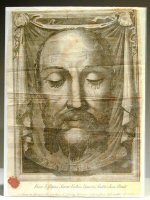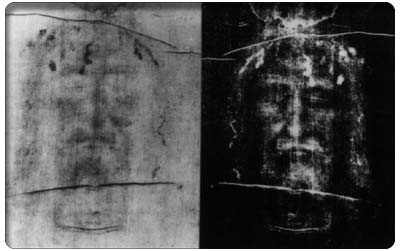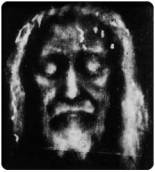Philosophy of Religion
Shroud of Turin : Miracle or not ?
As early as the sixth century there
have appeared certain images of Jesus that were said to be
acheiropoietoi--Greek for "not made with hands." There were different
versions of these and as many legends to explain their allegedly
miraculous origin.
Some modern writers have placed the Shroud of Turin in this genre.
Here is a list of Links to sites with lots of
information. Read over as much as you can. Read material on both sides of the issue, then make up your
mind.
WEBSITES
SCIENTIFIC FINDINGS
http://www.unisa.ac.za/dept/press/dearte/51/dearturn.html
http://humanist.net/appro-sindone/caldararo.html
http://www.shroud.com/bar.htm#article
Paint not Blood
http://www.mcri.org/shroudupdate.html
WEBSITE FOR THE SKEPTICAL VIEW
http://humanist.net/skeptical/shroud.html
Shroud of Turin Exhibition Renews False Claims of Authenticity
Amherst, N.Y.
For immediate release
Contact Matt Nisbet 716-636-1425
April 5, 1998
![]()
Beginning April 18, for the first time in twenty years, the Shroud of Turin will be on display to the public in Turin, Italy. Despite well-documented forensic and historical evidence to the contrary, the announced viewing has produced renewed claims that the Shroud of Turin is the authentic burial cloth of Jesus.
The following is a summary of the shroud debate by Joe Nickell, Senior Research Fellow with the Committee for the Scientific Investigation of Claims of the Paranormal (CSICOP.) Nickell is the author of sixteen books on investigation and the paranormal including Inquest on the Shroud of Turin. During the 1980's, Nickell served on a team of scholarly and scientific experts that evaluated the shroud claims and found them to be false.
The Council for Media Integrity is a network of prominent scientists, academics and members of the media concerned with the balanced portrayal of science in the media. It was launched at the 1996 First World Skeptics Congress and is sponsored by the Committee for the Scientific Investigation of Claims of the Paranormal (CSICOP, www.csicop.org).
For more information, contact Matt Nisbet at 716-636-1425 or SINISBET@aol.com.
The Shroud of Turin Controversy
Joe Nickell
For the first time in 20 years, the controversial Shroud of Turin will be placed on exhibit at its home in northern Italy. Not only are pilgrims expected to flock to the site, the Cathedral of St. John the Baptist in Turin, but many claims are expected to be made for the cloth by its defenders. Some facts are therefore in order.
Historically, the Shroud of Turin is one of some forty reputed burial cloths of Jesus, although it is the only one to bear the apparent imprints and bloodstains of a crucified man. Religious critics have long noted that the Turin shroud is incompatible with the bible, which describes multiple burial wrappings, including a separate “napkin” that covered Jesus’ face (John 20:5–7).
 |
The Turin cloth first appeared in north-central France in the mid-fourteenth century. At that time the local bishop uncovered an artist who confessed he had “cunningly painted” the image. Subsequently, in 1389, Pope Clement VII officially declared the shroud to be only a painted “representation.”
Years later, this finding was conveniently forgotten by the granddaughter of the original owner. She sold it to the House of Savoy, which later became the Italian monarchy. Eventually the cloth was transferred to Turin. In 1983 Italy’s exiled king died, bequeathing the shroud to the Vatican.
The shroud’s modern history has confirmed the assessment of the skeptical bishop and Pope Clement. Forensic tests of the “blood” — which has remained suspiciously bright red — were consistently negative, and in 1980 renowned microanalyst Walter C. McCrone determined that the image was composed of red ocher and vermilion tempera paint.
Finally in 1988 the cloth was radiocarbon dated by three independent labs using accelerator mass spectrometry. The resulting age span of circa 1260–1390 was given added credibility by correct dates obtained from a variety of control swatches, including Cleopatra’s mummy wrapping.
These findings are mutually supportive. The tempera paint indicates the image is the work of an artist, which in turn is supported by the bishop’s claim that an artist confessed, as well as by the prior lack of historical record. The radiocarbon date is consistent with the time of the reported artist’s confession. And so on.
The approach of impartial scientists has therefore been to let the evidence lead to a conclusion. In contrast, self-styled “sindonologists” (sindon being Greek for “shroud”) typically begin with the desired answer and work backward to the evidence — challenging anything that would seem incompatible with authenticity.
For example, they claim to have discovered microbial contamination on shroud samples that may have altered the radiocarbon dating. Yet for there to be sufficient contamination to raise the date thirteen centuries there would have to be twice as much debris, by weight, as the entire shroud itself! Moreover, the Vatican and the Archbishop of Turin have challenged the sample’s authenticity, and Walter McCrone insists that the fibers shown in photomicrographs of the piece of cloth “did not come from the ‘Shroud’ of Turin.”
For some, belief will always take precedence over historical and scientific evidence. For others, however, the realization that the shroud never held a body should come as no surprise.
Related Information
· Books by Joe
Nickell:
· Inquest
on the Shroud of Turin
· Looking
for a Miracle : Weeping Icons, Relics, Stigmata, Visions & Healing
Cures
· Entities
: Angels, Spirits, Demons, and Other Alien Beings
· Secrets
of the Supernatural : Investigating the World's Occult Mysteries
Other books:
· The
Blood and the Shroud : New Evidence That the World's Most Sacred Relic Is
Real
· Bible verse: John 20:5–7
· Science and the Shroud (magazine of The University of Texas Health Science Center at San Antonio)
· The Skeptic's Dictionary: shroud of Turin
· The Skeptical Shroud of Turin Website
· Time Magazine: Science and the Shroud (April 1998)
· CNN: Exhibit for disputed Shroud of Turin starts Sunday (4/18/98)
· Search CSICOP: Shroud of Turin
· Search Yahoo: Shroud of Turin
New "Shroud" Claims Challenged as Spurious
Amherst, N.Y.
June 1996 New claims concerning the Shroud of Turin, the reputed
burial cloth of Jesus, are being challenged by shroud experts. In fact,
leading authorities now question the authenticity of the cloth samples on
which the findings are based.
The new pro-shroud claims come from a team of four scientists from the University of Texas Health Science Center in San Antonio. The team claims -- based on threads allegedly taken from the shroud -- that heavy contamination from bacteria and fungi may have altered the 1988 radiocarbon dating. The implication is that the shroud might be genuine after all. One member of the team reportedly examined the DNA of markings on the cloth and identified them as blood from a human male.
|
|
|
A
fake shroud created by Joe Nickell |
However these findings are difficult to reconcile either with the cloth's history or with prior tests, say shroud experts. According to Joe Nickell, author of Inquest on the Shroud of Turin (1988) and an investigative writer for Skeptical Inquirer magazine, "There is abundant data on which to judge the shroud a forgery even apart from the carbon dating."
According to Nickell, the shroud first appeared in France in the 1350's, owned by a soldier of fortune who refused to say how he had obtained it. A subsequent bishop's report to Pope Clement detailed how the cloth was used in a healing scam to defraud pilgrims and how its apparent bodily imprint had been "cunningly painted" by a confessed artist.
Other evidence against authenticity, Nickell says, includes the image's resemblance to French gothic paintings as well as such obvious flaws as a lack of wraparound distortions and "blood" flows that are "picture like" and still bright red. In 1973 the "blood" failed a battery of forensic tests conducted by internationally known experts.
By 1980 new samples had been analyzed by microanalyst Walter McCrone who discovered that both image and "blood" areas had been painted by an artist using a red ocher and vermilion tempera paint.
Finally, in 1988 samples of the shroud's linen were radiocarbon dated by three independent laboratories. Their results were in close agreement and indicated the cloth was woven between 1260 and 1390 -- consistent with the time of the forger's confession, about 1355.

The new claims of contamination imply that the shroud is much older than the fourteenth century, possibly dating even from the first century, and that it could be genuine after all.
However, according to geochemist Paul Damon, professor emeritus at the University of Arizona and one of those who conducted the 1988 radiocarbon tests, "We've dated a lot of linen -- including many Coptic Christian samples -- and have been in close agreement with the historic date, within the precision of the dating method." Damon said he is confident his original findings are correct.
The recent study by the Texas team was conducted on a linen sample allegedly taken from the lower right corner of the shroud. However, the Archbishop of Turin, Cardinal Giovanni Saldarini, has publicly challenged the sample's authenticity. He stated that both he and the Vatican "declare that they cannot recognize the results of the claimed experiments."
Nickell points out that, even if the sample did come from the shroud, its location was far away from any alleged "blood" stains. "This is suspicious in itself and raises serious questions," states Nickell. "The persons involved should promptly and fully clarify the source and location of all the samples allegedly removed from the shroud."
Walter McCrone, who has, he says, "examined thousands of fibers from 32 different areas of the 'Shroud,'" maintains that the fibers shown in the team's photomicrographs "did not come from the 'Shroud' of Turin."
The notion that contamination could alter the carbon date from the first to the fourteenth century is "ludicrous," McCrone says, adding: "A simple calculation shows that a weight of modern biological material necessary to raise the shroud date 1300 years would weigh twice as much as the shroud by itself." Physicist Thomas Pickett from the University of Southern Indiana agrees, remarking that in such a case "it would be fair to say that the linen was contaminating the bacteria."
CONCLUSION:
http://www.skeptiseum.org/exhibits/feature%20exhibit/index.html
There is more evidence to support the conclusion that the shroud is a forgery and a deliberate fake than that it is a cloth from 2,000 years ago that may have covered the body of Christ.
1. The cloth is too well preserved to be as old as claimed.
2. Radio active carbon dating indicates that it is not as old as claimed.
3. The type of fabric and complex herringbone weave were not known 2,000 years ago in that land. There are no other examples of it from that period.
4. Jewish burial practices of the time and the description in John involves multiple burial wrappings with a separate cover over the face.
5. There is no evidence in the historical record of the shroud until the mid-fourteenth century when a bishop reported the confession of an artist associated with it.
6. The shroud lacks the distortion of the image that would have been caused by wrapping it around a human body.
7. The image on the shroud has a strong resemblance to medieval depictions of Jesus.
8. The bright red areas that appear as if they are blood stains failed to indicate any blood being present under a battery of the most advanced tests available to detect blood.
9. Testing indicates the presence of red ocher in body areas and red ocher with vermillion in the areas that appear as blood.
Other Resources:
The Shroud of Turin: All sides of the issue: http://www.religioustolerance.org/chr_shro.htm
Religious sites promoting a
1st century origin of the shroud:
|
Skeptical sites promoting a
14th century origin of the shroud:
|
Neutral sites:
|
Unusual sites:
|
Commercial sites:
|
Return to the section on miracles by clicking here>miracles
© Copyright Philip A. Pecorino 2001. All Rights reserved.
Web Surfer's Caveat: These are class notes, intended to comment on readings and amplify class discussion. They should be read as such. They are not intended for publication or general distribution.
